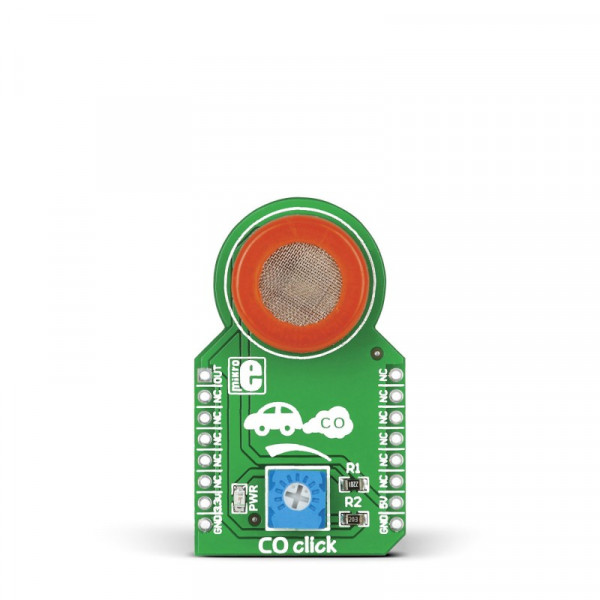Prices incl. VAT plus shipping costs
Ready to ship today,
Delivery time appr. 1-3 workdays
- Order number: MIKROE-1626
- Manufacturer product ID: MIKROE-1626
CO click carries the MQ-7 gas sensor with high sensitivity to carbon monoxide. The click is designed to run on a 5V power supply only. It communicates with the target microcontroller over the AN pin on the mikroBUS™ line.
The board also features a calibration potentiometer, a mikroBUS™ host socket, two jumpers and a power indicator LED.
MQ-7 sensor features
The MQ-7 sensor has high sensitivity to carbon monoxide. The gas sensing layer on the sensor unit is made of Tin dioxide (SnO2), which has lower conductivity in clean air. The conductivity increases as the levels of Carbon monoxide rise. The detection range of the sensor is 20ppm-2000ppm of CO.
Calibrating the sensor
To calibrate the sensor for the environment you’ll be using it in, CO click has a small potentiometer that allows you to adjust the Load Resistance of the sensor circuit. For precise calibration, the sensor needs to preheat (once powered up, it takes 48h to reach the right temperature).
Carbon monoxide detection
Carbon monoxide gas sensors are used to detect the presence of that gas and prevent carbon monoxide poisoning.
Since carbon monoxide has no smell or color, humans cannot detect it. In high concentrations, it can be lethal.
Key features
- MQ-7 sensor
- Sensor range: 20ppm-2000ppm of CO
- Onboard potentiometer for calibration
- Communicates over the AN pin
- 5V power supply
Specification
| Type | Gas |
| Applications | Measuring pollution, designing safety alarms, performing experiments |
| On-board modules | MQ-7 sensor for Carbon monoxide |
| Key Features | Gas sensing layer on the sensor unit is made of Tin dioxide (SnO2) |
| Key Benefits | Potentiometer for calibration |
| Interface | Analog |
| Input Voltage | 3.3V or 5V |
| Compatibility | mikroBUS |
| Click board size | M (42.9 x 25.4 mm) |
Pinout diagram
This table shows how the pinout on CO click corresponds to the pinout on the mikroBUS™ socket (the latter shown in the two middle columns).
Programming
Code examples for CO click, written for MikroElektronika hardware and compilers are available on Libstock.
Code snippet
The following code snippet shows how to initialize the click, and then read from it, showing the values on the display.
01 void main() {
02
03 LCD_Init(); // Initialize Lcd
04 Lcd_Cmd(_LCD_CLEAR); // Clear display
05 Lcd_Cmd(_LCD_CURSOR_OFF); // Cursor off
06 Lcd_Out(1,1,"CO click"); // Write text in first row
07
08 ANSELA = 0x04; // Set ADC on RA2
09 TRISA = 0x04; // Set RA2 as input
10 LATA = 0; // Set PORTA as 0
11 ADC_Init(); // Initialize ADC
12 delay_ms(100); // Pause of 100ms for ADC module stabilization
13
14 //Initial read ADC and display PPM value on LCD
15 readSensor(); // Read sensor
16 calculatePPM(); // Calculating PPM value
17
18 FloatToStr(ppm,&txt); // Conversion float ppm to string txt
19 LCD_Out(2,14,"ppm"); // Print text on LCD
20 LCD_Out(2,1,txt); // Print txt value on LCD
21
22 while(1) {
23
24 delay_ms(500); // Pause 500ms
25 readSensor(); // Read sensor
26 calculatePPM(); // Calculating PPM value
27 FloatToStr(ppm,&txt); // Conversion float ppm to string txt
28 LCD_Out(2,1,txt); // Print txt value on LCD
29
30 }
31 } 








